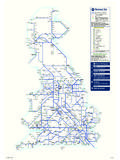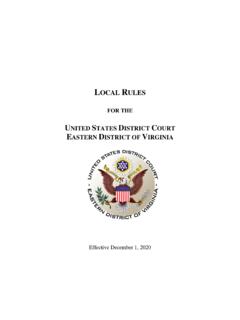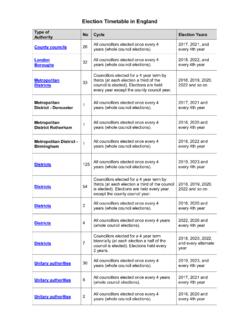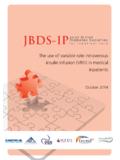Transcription of History of Ambulance - Northampton General Hospital
1 The History of the Ambulance ServiceThe concept of Ambulance service started in Europe with the Knights of St. the Crusades in the 11thcentury, the Knights of St. John receivedinstruction in first-aid treatment from Arab and Greek doctors and acted as thefirst emergency workers. They treated soldiers from both sides of the war andprovided care to the poor, sick and injured of the History of the Ambulance Service1882St John Ambulance Association introduced Invalid Transport Corps free of charge tothe poor. Becomes St John Ambulance Brigade in ambulances replaced by time ambulances released for civilian use andnational Ambulance Health Act provides fortransport of non-urgentcases and Ambulance servicesspread slowly acrossthe country until telephone number was Health Services Act requires local authoritiesprovide ambulances wherenecessary.
2 Initially staffed by volunteers, professionals are introduced Millar report recommends that the Ambulance societyshould provide treatmentas well as carry people to of of helicopters and motorbikes to speed upresponse timesDefibrillators became portable and introduced onto sStaff with extended training re-qualify as Formation of Northampton Ambulance CorpsOn 14thSeptember 1887, theNorthampton Ambulance Corps was founded and awheeled litter was bought. This was awheeled carriage,with iron rimmedwheels, thatcarried a canvas stretcherandwas kept at Northampton patients were brought to the Infirmary by train and met at the station but itwasstilla laborious way to carry patients to and from the Infirmaryandso in 1888 it wasdecided to purchase a horse drawn , cab manufacturersofBridge Street, Northampton built this firstambulance at a cost of , plus for the rubber for supplying horses was by a Mr Frisby, Carriage and Cab Proprietor of 29 Market Square.
3 He stipulated that his business took priority with regard to use of hishorses, funerals andweddings coming first, followed by his cab hire and beforeambulance for use of Horse Ambulance = 3 shillings per mileCharges for Wheeled Litter = 2d per mileReduced charges for persons holding Infirmary letters or leaving the cases moved free of photo, provided by Joy Arthurs Page, shows her great grandfather Sydney-ClenchArthurs on the right by the litter. Sam Frisbyis sitting on the box, John Perry standing byhim and Harvey Reeves, the Transport Officer, on the Reeveswent on to bethe Superintendent of Northampton Headquarters Division of St John Ambulance Corps,and is better known as Mayor of Northampton in 1912and 1920.
4 In hisfirstyear ofoffice, he raised money to provide this motorised MrF Newton, Councillor Harvey Reeves (Mayor of Northampton ),Dr W M Robson, Supt. Rice and Corporal RicksOn April 26th, 1913, this Napier motorised Ambulance arrived inNorthampton, having aroused great interest on its wayfromthe Londonfirm of Reeves, along with Superintendent Rice of the local foundryfamily, was responsible for the design and many ambulances of this typewere sold throughout the ! Unfortunately this Ambulance was involved in a roadaccident ashort time later. ( Not sure of the year)Alderman W. Harvey Reeves ( 1871-1932)When William Harvey Reeves came to Northampton from St Albans, his firstintroduction to public work was working in the office of the clerk to the boroughmagistrates.
5 When his step-father Mr E Barnes became ill, he was called to assist inthe business of Messrs. E Barnes and Co., waste merchants of Kingswell St., taking fullcharge of the business after his was a councillor and served two terms asMayorof Northampton , 1912 and1930. Duringhis first term of office, his charity was to provide funds for a motorambulance and Northampton Ambulance Corps and Northampton Corporation jointlypurchased this at a cost of 700. In his second term, he took a lead in the endeavourto clear the Northampton General Hospital s huge debt. Nearly 9,000 was raised andthe deficit an Ambulance driver andworked with the Order of St.
6 John of Jerusalem for43years, holding the office of Transport Officer in 1889 andbecomingSuperintendent of Northampton Headquarters WW1 he worked as a Red Cross worker for the Voluntary Aid Detachment(VAD).The Red Crosstookover the responsibility of caring for the war was a Deputy Lieutenant and served as a a Freemason he was Worshipful Master of Kingsley Lodge in 1918, held the officeof Provincial Grand Warden and as a member of the Northampton Chapter had heldthe office of Provincial Grand worked for children in the early daysof the Crippled Children s Fund and wasChairmanof the ManfieldHospitalFinance Harvey Reeves.
7 Mayor 1912-13 and 1920-21 Thomas Henry Woolston CBE. DL. JP. (1855-1927)Mr Woolston was a qualified pharmacistand acquired a business in Bridge St, Northampton in forceswith Mr North and this chemist shop waslater known as North and Roper .At the time he had been the pioneer of the Ambulance movement in Wellingboroughand rose from the ranksto be Superintendent. He also founded and became theSuperintendent of the Kettering Corps. On coming to Northampton he threw himselfheart and soul into Ambulance workandwas lieutenant toMr Harvey he was promoted to Assistant Commissioner of Central and the start of WW1, Mr Woolston was asked by the War Office to mobilise the VAD sand he supervised 32 hospitals dealing with 22,558 stricken suffered heartproblems in later life and whilstconvalescing in Wales, he and hiswife were out taking a gentle stroll when he collapsed.
8 An Ambulance was called forbut he died on his way to Hospital . His family thought that with all his involvementwith the Ambulance movement, it was a fitting wayto young Mr WoolstonWorld War 1As far back as 1910 the War Office had called upon members of AmbulanceBrigade to volunteer in case of war. There was a great response,from both malesand females,and they were formed into Voluntary Aid Woolston was appointed County Director, Mr W. Harvey Reeves as AssistantDirector and Mrs Harvey Reeves Assistant County RedCross/VAD photo showing Mr Woolston on the left, Harvey Reeves on theright, flanking Earl General consent, it was a marvel of organisation, foresight and tender and welltrained care and was highly regarded by the military authorities.
9 NorthamptonshireRed Cross was held as a model to all other Model T Ford Ambulance outside NGH 1918 Joseph GroseJoseph George Grose (1861-1939)Joseph Grose owned a car show room in Marefair Northampton and workshopsand garagesaround the corner in Pike Lane. Considerable business was doneconverting private cars to ambulances, many of which were donated frompatriotic locals and firm also developed a two-wheeled Ambulance trailer for use of the VAD andsimilar organisations. These could be towed behind any car and carried twostretchers,were lightly sprung and s second son was an Ambulance driver for the British Red youngest son, Lieutenant Albert George Grose, was killed in action in 1917,serving with the Royal Flying War 2 Before the war started, locallyadministered ARP(Air Raid Precautions)casualtyservice groups were established utilising St John Ambulance and Red local St John Ambulance Brigade wasbadly in need of a new Ambulance at thistime and Mr Sears ( Boot and Shoe manufacturer) came to the rescue,commissioning Grose to build a body on a (probably second hand)
10 Rolls s garage in Marefair/Pike Lanewere againconvertingseveral private cars toserve as ambulances. Two brand new Vauxhall chassis stored on joists in the PikeLane works were retrieved and given Ambulance Grose bodied Ambulance for St John Ambulance Brigade on 1939 25hp Vauxhall chassis, basedat the Margaret Spencer Convalescent Home in of the ARP service team learn how to drive and repair a Corporation bus. Many of thesebuses were converted to use as the outbreak of WW2, the AmbulanceCorps with the British Red Cross were puton full alert. Converted horse boxes were used as first aid posts which,after the war,would be used at large public events.






